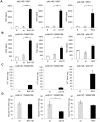Quantification assays for total and polyglutamine-expanded huntingtin proteins
- PMID: 24816435
- PMCID: PMC4016121
- DOI: 10.1371/journal.pone.0096854
Quantification assays for total and polyglutamine-expanded huntingtin proteins
Abstract
The expansion of a CAG trinucleotide repeat in the huntingtin gene, which produces huntingtin protein with an expanded polyglutamine tract, is the cause of Huntington's disease (HD). Recent studies have reported that RNAi suppression of polyglutamine-expanded huntingtin (mutant HTT) in HD animal models can ameliorate disease phenotypes. A key requirement for such preclinical studies, as well as eventual clinical trials, aimed to reduce mutant HTT exposure is a robust method to measure HTT protein levels in select tissues. We have developed several sensitive and selective assays that measure either total human HTT or polyglutamine-expanded human HTT proteins on the electrochemiluminescence Meso Scale Discovery detection platform with an increased dynamic range over other methods. In addition, we have developed an assay to detect endogenous mouse and rat HTT proteins in pre-clinical models of HD to monitor effects on the wild type protein of both allele selective and non-selective interventions. We demonstrate the application of these assays to measure HTT protein in several HD in vitro cellular and in vivo animal model systems as well as in HD patient biosamples. Furthermore, we used purified recombinant HTT proteins as standards to quantitate the absolute amount of HTT protein in such biosamples.
Conflict of interest statement
Figures






Similar articles
-
A series of N-terminal epitope tagged Hdh knock-in alleles expressing normal and mutant huntingtin: their application to understanding the effect of increasing the length of normal Huntingtin's polyglutamine stretch on CAG140 mouse model pathogenesis.Mol Brain. 2012 Aug 14;5:28. doi: 10.1186/1756-6606-5-28. Mol Brain. 2012. PMID: 22892315 Free PMC article.
-
Development of mAb-based polyglutamine-dependent and polyglutamine length-independent huntingtin quantification assays with cross-site validation.PLoS One. 2022 Apr 8;17(4):e0266812. doi: 10.1371/journal.pone.0266812. eCollection 2022. PLoS One. 2022. PMID: 35395060 Free PMC article.
-
Effects of overexpression of huntingtin proteins on mitochondrial integrity.Hum Mol Genet. 2009 Feb 15;18(4):737-52. doi: 10.1093/hmg/ddn404. Epub 2008 Nov 27. Hum Mol Genet. 2009. PMID: 19039036 Free PMC article.
-
Selective degeneration in YAC mouse models of Huntington disease.Brain Res Bull. 2007 Apr 30;72(2-3):124-31. doi: 10.1016/j.brainresbull.2006.10.018. Epub 2006 Nov 16. Brain Res Bull. 2007. PMID: 17352936 Review.
-
Polyglutamine Expansion in Huntingtin and Mechanism of DNA Damage Repair Defects in Huntington's Disease.Front Cell Neurosci. 2022 Apr 4;16:837576. doi: 10.3389/fncel.2022.837576. eCollection 2022. Front Cell Neurosci. 2022. PMID: 35444517 Free PMC article. Review.
Cited by
-
Deep-learning analysis of micropattern-based organoids enables high-throughput drug screening of Huntington's disease models.Cell Rep Methods. 2022 Sep 19;2(9):100297. doi: 10.1016/j.crmeth.2022.100297. eCollection 2022 Sep 19. Cell Rep Methods. 2022. PMID: 36160045 Free PMC article.
-
Preclinical evaluation of the novel [18F]CHDI-650 PET ligand for non-invasive quantification of mutant huntingtin aggregates in Huntington's disease.Eur J Nucl Med Mol Imaging. 2024 Dec;52(1):122-133. doi: 10.1007/s00259-024-06880-x. Epub 2024 Aug 27. Eur J Nucl Med Mol Imaging. 2024. PMID: 39190197 Free PMC article.
-
Polyglutamine expansion affects huntingtin conformation in multiple Huntington's disease models.Sci Rep. 2017 Jul 11;7(1):5070. doi: 10.1038/s41598-017-05336-7. Sci Rep. 2017. PMID: 28698602 Free PMC article.
-
Disease-related Huntingtin seeding activities in cerebrospinal fluids of Huntington's disease patients.Sci Rep. 2020 Nov 20;10(1):20295. doi: 10.1038/s41598-020-77164-1. Sci Rep. 2020. PMID: 33219289 Free PMC article.
-
Development of novel bioassays to detect soluble and aggregated Huntingtin proteins on three technology platforms.Brain Commun. 2021 Jan 5;3(1):fcaa231. doi: 10.1093/braincomms/fcaa231. eCollection 2021. Brain Commun. 2021. PMID: 33604571 Free PMC article.
References
-
- The Huntington's Disease Collaborative Research Group (1993) A novel gene containing a trinucleotide repeat that is expanded and unstable on Huntington's disease chromosomes. Cell 72: 971–983. - PubMed
-
- Sharp AH, Loev SJ, Schilling G, Li SH, Li XJ, et al. (1995) Widespread expression of Huntington's disease gene (IT15) protein product. Neuron 14: 1065–1074. - PubMed
Publication types
MeSH terms
Substances
LinkOut - more resources
Full Text Sources
Other Literature Sources

